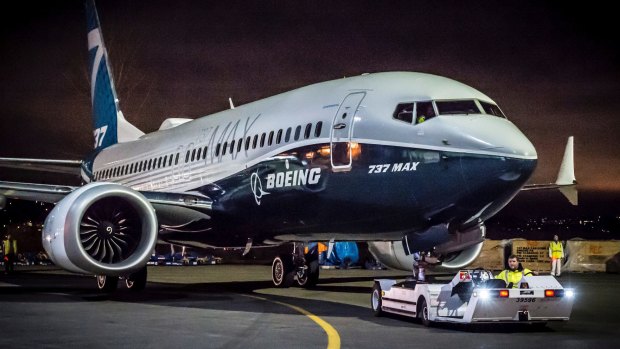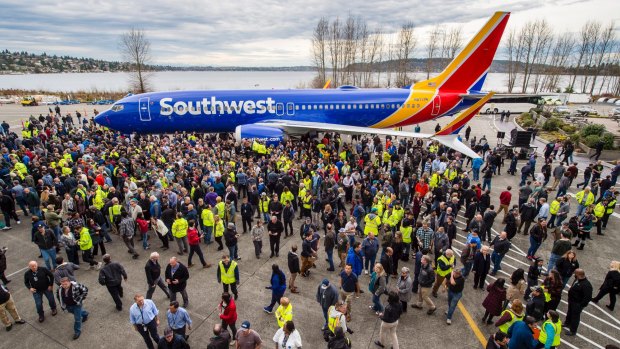This was published 6 years ago
Boeing's best-selling 737 jet hits historic milestone: 10,000 planes produced
By Dominic Gates

The Boeing 737 is the best-selling airline jet in history.Credit: BOEING
Boeing celebrated production of its 10,000th single-aisle 737 on Tuesday, putting what is already the best-selling jet of all time on track to become the best-selling large transport plane in history.
With the delivery of the 10,000th 737, Boeing broke the Guinness World Record title for the most produced commercial jet aircraft model.
Yet when the plane first flew more than 50 years ago, no one could have guessed its destiny.

Boeing employees at the company's facility in Renton celebrate the 10,000th 737 to come off the production line. Credit: BOEING
The pilot in command on that first flight, now 93, recalled hopping around the globe in 737s in the years after the plane's 1967 debut to goose flagging sales.
"At the time of its birth, we were struggling to attract airlines at all," said pilot Brien Wygle in a phone interview. "I don't think anybody could have foreseen the extreme success of the airplane in the long run."
Bob Bogash, 73, who as an engineer helped build the first plane, flew in a later globe-spanning sales flight aboard the 1000th 737.
He recalled a gruelling journey in 1984 from Seattle across North America, then over the North Atlantic via Iceland to various European capitals, crossing the Sahara to visit nine countries in Africa as far south as Zimbabwe, then flying over the South Atlantic to French Guiana and Venezuela, before returning home to Seattle via Puerto Rico and Memphis - 19 countries in 27 days, routinely waking at 5 a.m. and getting to bed around midnight.
"You never stayed in one place. You had nowhere to do your laundry. In half these places, you couldn't drink the water. You brushed your teeth with Chivas Regal," Bogash said. "But you can sell a lot of airplanes that way."
Especially productive were the Stockholm and Amsterdam stops, where the Boeing team persuaded SAS and KLM, two airlines that flew Douglas Aircraft DC-9s, to flip to the 737.
"Those were two big wins on that tour," Bogash said. "Each ended up with a few hundred planes."
The 737's evolution over five decades shows a progression from a short, stubby puddle-jumper to a much-larger plane carrying twice as many passengers more than twice the distance.
The plane celebrated Tuesday was the latest 737 MAX 8.
To mark the occasion, top 737 customer Southwest Airlines donated to the Boeing employee community fund a check for $US10,000 earmarked for disaster relief.
Among several hundred employees present was David Knowlen, 74, who started at the company 52 years ago and was present at the 1967 rollout of the first 737 at Boeing Field.
Today, he's on a special projects team that works to preserve Boeing's legacy in aviation history by working with museums and other institutions.
Knowlen recalled that at the rollout, a row of flight attendants from airlines that had ordered the new jet christened it by smashing a Champagne bottle over the wing.
Over 50 years later, he said, the biggest change is in how the plane is built.
His job back then was to check the alignment of parts going on the plane. Today, the assembly process is increasingly automated and the production rate has correspondingly accelerated.
Boeing delivered the first 5000 planes between 1967 and 2006. The second 5000 have been delivered in just the last dozen years.
In the early days, "Everything was done manually," Knowlen said. "The amazing thing is it went together so quickly and so smoothly, considering the fact that it was mostly a hand-built plane."
Constant renewal
When that first 737 rolled out at Boeing Field, Renton was still building 707s and 727s, the Everett plant was still under construction for the new 747 jumbo jet, and much of the world's attention was focused on Boeing's Developmental Center in Seattle where the Supersonic Transport (SST) was being developed.
The SST was cancelled. The 707 and 727 are long gone. And the 747 may not survive long beyond 2020.
See also: Into the boneyard: Where 747 jumbo jets go to die
But over the next eight to 10 years, Boeing will still be building the 737, which over five decades has gone through four major iterations to arrive at its latest incarnation, the new 737 MAX.
The original plane, the 737-100, was short and stubby, designed to be a "puddle-jumper," flying short-haul routes such as Seattle to Spokane.
But its performance was disappointing, said first-flight pilot Wygle. Drag was higher than expected, resulting in less range, higher fuel burn and steeper operating costs.
"There was a lot to do to the plane before we got it right where we wanted it," said Wygle.
Boeing tweaked the aerodynamics in steps and then in 1981 introduced a significant update with the 737-300, -400 and -500 variants - referred to now as the "Classic" 737 models - featuring new high-bypass, highly efficient CFM engines and improved avionics.
"That made the big difference," said Wygle.
The next 737 refresh, in 1993, was almost a new plane.
Shocked by United Airlines' purchase of the rival Airbus A320 in 1992, the following year Boeing launched the so-called 737 Next Generation - the 737-600, -700, -800 and -900 models - with a new wing and ever-more-efficient CFM engines.
This was a hugely successful variant, with about 6600 delivered to date.
Southwest made it the go-to plane for the new "low-cost carrier" airlines that wanted an efficient, reliable flying machine with fast turnaround times.
Today, Southwest is the jet's leading customer, with an all-737 fleet of more than 700 planes and more than 400 others on order.
The proliferation of low-cost flights pioneered by Southwest on the 737 has made flying mundane, if often stressful. But it has also brought a huge expansion of air travel as middle-class people all over the globe embrace flying.
Today, Boeing estimates that more than three million passengers fly on 737s around the world every day.
Southwest's vice president of maintenance operations, Landon Nitschke, said Tuesday that his airline alone carried 542,000 passengers on one particularly busy day.
Boeing Commercial Airplanes chief executive Kevin McAllister noted that since the jet first entered revenue service, 737s have carried about 23 billion passengers in total.
"When you can carry three times the world's population in an airplane like this, that's something to wake up for every day," he told the assembled employees.
Parked behind McAllister as he spoke was the jet that is surely the final 737 iteration - the 737 MAX.
The launch of this model was again provoked by Airbus, when the European jetmaker sold its A320neo - the A320 with a new engine - to American Airlines in 2011.
Boeing immediately dropped plans for an all-new 737 replacement that would have taken years to develop, in favor of re-engining the 737 to create the MAX 7, 8, 9 and 10 models.
On Friday, Boeing expects to have the first flight of the smallest MAX model, the MAX 7.
The original 737-100, less than 28 metres long with a wingspan of 28 metres, had a range of about 2840 kilometres and in two classes seated fewer than 100 passengers.
The 737 MAX 8, almost 40 metres long with a wingspan of nearly 36 metres, has a range of more than 6400 kilometres seating nearly 180 passengers.
The added range capability is now opening up a new era of low-cost carrier international flights, with operators such as Norwegian flying nonstop across the Atlantic.
Race with the A320
With more than 4,600 unfilled orders still to be delivered, within three years the 737 should surpass the propeller-driven Douglas Aircraft DC-3 in total numbers produced.
Just over 600 of those were built for civilian use, and then 10,000 more were produced during World War II as C-47 military transports.
Including Japanese and Russian licensed models, more than 16,000 DC-3 variants were built worldwide. Before the MAX ends its run, the 737 could surpass even that target.
The first 737 was built in Plant 2 at Boeing Field, before a production line was set up at the nearby Thompson site. Altogether, 271 of the planes were built at Boeing Field.
Production moved to Boeing's Renton factory in 1970, and the rest of the 10,000 rolled out there.
In a testament to just how fierce is the 737's competition from the Airbus A320 jet family, it's noteworthy that although the A320 entered service two decades later than the 737, Airbus has already delivered more than 8000 of those models and has another 6000-plus on firm order.
That means the Airbus jet, a relative stripling, is running neck and neck with the 737 for the largest final order count.
As the two rivals battle for sales in the booming single-aisle market, each is using new automated manufacturing equipment to accelerate production to unheard-of levels.
The Renton 737 plant will ratchet up production from 47 jets per month to 52 per month around midyear, ahead of an announced rate hike to 57 per month in 2019.
And speculation is rife that Boeing will go higher still, to 63 planes per month and perhaps higher.
On Tuesday, Renton site leader Scott Campbell referred to the factory, with some justification, as "the most efficient manufacturing place in the world."
Last year, about 42 per cent of Boeing's commercial plane sales revenue came from the 737.
As production spikes in the next few years, that proportion will grow. The aging baby of Boeing's jet lineup will provide the largest slice of the cash flow needed to fund its future new planes.
At Tuesday's ceremony, two longtime 737 workers - Darry Woodson, a Machinist union shop steward who helps build the wings; and Skip Frett, another machinist who installs interiors - talked about the pride they feel in their work and how it's allowed both to raise their children, buy homes and build strong middle-class lives.
"I've raised four beautiful daughters thanks to the Boeing Company," said Woodson.
Observing the employees crowding happily around the plane, 737 veteran Knowlen remarked on the passing of time and what's not changed at Boeing since the rollout in 1967.
"These are all kids," he said. "They are laughing and having fun just like I did 50 years ago."
737 facts
- A 737 takes off or lands around the world every 1.5 seconds
- On average, more than 2,800 737s are in the air at any given time
- More than 22 billion people have flown on a 737
- The 737 has flown more than 196 billion kilometres, the equivalent of 5 million times around Earth
TNS
Sign up for the Traveller newsletter
The latest travel news, tips and inspiration delivered to your inbox. Sign up now.